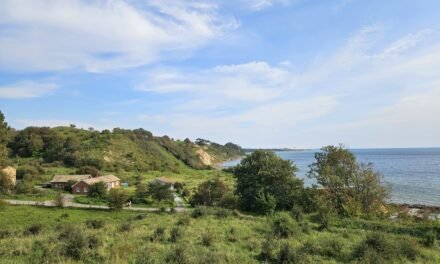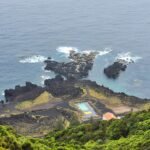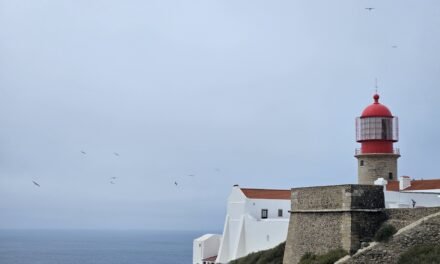
The Fisherman’s Trail Portugal: Guide and Itinerary

The Fisherman’s Trail Portugal offers a remarkable hiking experience along its breathtaking coastline. Before delving into the Fisherman’s trail Portugal itinerary and our personal experiences, let’s begin with some key details about this remarkable trail. You can also find the Fisherman’s trail map further in this article.
Before we dive into the specifics, we may need to clarify the differences in the names you may have heard like Rota Vicentina, Fisherman’s trail, Historical Way, Circular Way, Caminho Atlantico, GR11,and so on. The Fisherman’s Trail we will be discussing further in this blog post is part of the Rota Vicentina network. this network of trails includes both the Fisherman’s Trail and the Historical Way. The Fisherman’s Trail primarily follows the coastline, offering stunning views of the ocean, while the Historical Way takes a more inland route, passing through rural landscapes, forests, and historical towns and villages. While the Fisherman’s Trail Portugal primarily follows the coastline, it does intersect with and connect to other trails within the network.
The key trails that intersect or connect with the Fisherman’s Trail Portugal:
- Historical Way (also known as Caminho Histórico): It intersects with the Fisherman’s Trail at various points. The Historical Way markings are red and white. Officially begins in the town of Santiago do Cacém and ends in the town of Cabo de São Vicente. The latter is situated near Sagres and is known for its iconic lighthouse, marking the southwesternmost point of mainland Europe.
- Local Trails: In addition to the main Fisherman’s Trail and Historical Way, there are numerous local and regional trails in the Alentejo and Algarve regions of Portugal. These trails may intersect with or connect to the Rota Vicentina network, providing further options for exploration.
- Circular Routes: There are several circular routes and alternative paths that connect to the Fisherman’s Trail (Rota Vicentina) and provide opportunities for shorter hikes or loops. These circular routes often start and end at points along the Fisherman’s Trail, allowing hikers to explore specific areas more thoroughly. The markings have red and yellow colors.
How to reach the starting point:
Depending on your starting point (e.g., Lisbon, Porto, Faro), consider taxis or buses. We traveled from Faro via taxi. It costed us somewhere between 30-50 euro, but we didn’t know as this was prebooked for us by the travel аgency.
Best time to walk the Fisherman’s trail Portugal:
Best Seasons: While summer is hot and bustling (particularly in July and August), May offers milder temperatures. October and early November might be also ideal for hiking. December to March is also an option, though be prepared for chilly ocean winds. We hiked in late August and early September, enjoying constant 23-degree weather. The ocean breeze was refreshing along the cliff-lined sections, and occasional clouds made it perfect for hiking. While we were fortunate not to encounter rain, it’s wise to pack rain gear if it’s in the forecast.
Fisherman’s Trail Portugal Highlights

- Length: Varies. We chose to walk from Porto Covo to Sagres, covering in total 191 km
- Elevation gain: relatively flat, few elevation gains and losses
- Terrain: diverse terrain, sand, dusty roads, inland routes, aslphalt
- Route Markings: Blue and green markings
- Starting points: Flexible starting points. We choce to walk from Porto Covo
Length | The Fisherman’s Trail (Rota Vicentina) spans a total of 191 kilometers (From Porto Covo to Sagres), but it can be tailored to your preference. Some opt for a 4-day hike from Porto Covo to Odeceixe, while others, like us, embark on a 9-day journey from Porto Covo to Sagres, covering 191 kilometers. There is also a possibility to complete the trail from Santiago do Cacém to Sagres or from Porto Covo all the way to Lagos, covering about 230 km. The Historical Way comprises a total of 13 sections and 263 km, as it has two diversions from the route from Odemira to Sabóia and from Cercal do Alentejo to Porto Covo. As you guessed, there are plenty of options there. |
Elevation gain | The Fisherman’s Trail Portugal is relatively flat, with minimal elevation gain and loss. It follows the coastal terrain, and while you’ll encounter some ascents and descents, they are not very steep but it would depend on your physical level how you assess the trail. |
Terrain | The Fisherman’s trail Portigal offers diverse walking surfaces, from sandy beaches to rugged cliffs, as well as inland routes in the mountain national park. |
Route Markings | Keep an eye out for the distinctive blue and green markings, though they may disappear in places like Rogil, where you’ll follow red and white markings. Additional routes with yellow and red markings are worth exploring. |
Starting points | The trail is flexible; you can start and stop at various points. We recommend starting from Porto Covo and explore the whole trail, but you can tailor the trail to your liking and start basically at any of the starting point of the stages (see below for overview of the stages). |
Luggage Delivery Services

- To make your Fisherman’s Trail Portugal experience easier, we recommend booking luggage transfer
- There are various luggae transfer services available, we recommend Vicentina Transfers
- Note that some services do not operate during some months of the year. Remember to check availability
- Average cost: 15 Euro per stage for 1 suitace/bag (no more than 20kg though).
We opted for a luggage delivery service, which definitely made our hiking experience much more enjoyable and we could bring extra clothes and belongings with us. We had to leave the luggage at the hotel’s reception in the morning around 8 am, and it had typically arrived before check-in time, around 3 pm. In terms of pricing and transport companies, we recommend Vicentina Transfers. From our personal experience, we found the company to be extremely accurate and in time with the luggage, and we felt that the luggage was secure at all times. It costs 15 Euro per stage for 1 suitace/bag (no more than 20kg though).
Accomodation along the route

- Accommodation options include camping, hostels, hotels
- Most hotels and hostels offer breakfast
- Campsites, that we know of, are in Porto Covo, Vila Nova de Milfontes, Zambujeira do Mar, Odeceixe, Aljezur, and Sagres
- Book accommodation as early as possible
Most hotels provide breakfast, which was consistently delightful with a variety of options. Advance booking is advisable, especially during the peak months between June and August. Below is a list of the hotels we stayed in. We were very happy with all the services at the hotels, including cleanliness and friendly staff. But what we should warn is that some of the stars of some of the hotels were either missing or were too much than what was stated in the booking system ans websites. But truly we had no bad feelings about any of the places below. Here are the hotels we stayed in and links to Booking website.
| Vila Nova de Milfontes | HS Milfontes Beach 3* hotel ( we stayed 2 nights at the hotel and had a taxi that drove us to Porto Covo to start the trail.) |
| Almograve | Vicentina Rooms by Casas do Alentejo 2* hotel |
| Zambujeira do Mar | Rosa dos Ventos 2* hotel |
| Odeceixe | Casas do Moinho BB Odeceixe 5* hotel |
| Aljezur | Vicentina Hotel 4* hotel |
| Arrifana | Vale da Telha 2* hotel |
| Carrapateira | Casa Fajara Boutique House & Hotel 3* hotel |
| Vila Nova do Bispo | Hotel Mira Sagres 3* hotel |
| Sagres | Mareta Beach Boutique B&B 3* hotel |
Difficulty of the Fisherman’s Trail Portugal

- Diverse: Sand roads and beaches, sand dunes, inland pathways, ascends and descends, rocky pathways, cliffs, aslphalt
- First 4 days: mostly sandy pathways with few ascends and descends
- Last 3 days: mostly inland roads, dusty and rocky pathways
- No shade
- Proper shoes and sun protection needed
- Have water at all times
The trail may seem challenging due to sand dune walking, limited shade, and potential strong sun. Prepare with sun protection, water, and a light backpack. While there are a few ascents and descents, as well as quite long flat stretches, the difficulty depends on your physical fitness. We found it manageable, often stopping at scenic beaches and cliffs along the way.
The best part of the fisherman’s trail Portugal

- Cliffs and beautiful forests
- Sand dunes, sand and amazing beaches
- Mesmerizing viewpoints
- Historic cities,e.g. Odeceixe, Aljezur and Sagres
- Lighthouses, chapels, churches and a fortress
- Surfing paradise & Fishermen
- Animals: ostrich farm, storks and other birds
- Best sunsets are in Portugal
The Fisherman’s Trail (Rota Vicentina) rewards hikers with stunning natural beauty, ocean views, secluded beaches, dramatic cliffs and diverse landscapes. While most stages follow the coastline, some venture inland, adding variety to the trail. However, we did encountered the consequences of a fire between Arrifana and Carrapateira, which was disheartening. You’ll also encounter charming old villages like Odeceixe and Aljezur and resort-style villages. The breathtaking sunsets, especially from cliff vantage points or golden sandy beaches, are unforgettable. We recommend to enjoy a sunset at Zambujeira do Mar, near Praia de Nossa Senhora.
What to pack for daily hike

- Pack light and only essentials
- Water,snack and lunch
- Sun protection: hat, sunglasses and sun protection lotions
- If rain is in the forecast, bring rain gear
- Valuables,e.g. documents, money, electronics
- Charger for your phone
- Medicine: plasters for blisters and any painkillers or other essential medicine
- Walking poles
Essentials include water, food, sun protection (hat and glasses), and rain gear if needed. Pack light to avoid overburdening yourself. Carry any necessary medication and blister plasters. A swimsuit and towel can be handy for impromptu beach stops. We recommend bringing essential electronics (phone, camera, etc.) and valuables like documents, debit/ credit cards and passports, to ensure they remain safe during the hike. We brought with us also walking poles, but these are optional.
Food and restaurants

- Supermarkets and Restaurants can be found in all places we stayed. Check the opening hours beforehand
- Avoid tap water and buy bottled water, which is inexpensive
- Meals costs for 2 at restaurant can vary, typically start from 40€
- Most hotels and hostels offer breakfast, prices vary
Most cities and villages along the route have supermarkets. While the food selection may be limited in most of the village supermarkets we stoped, it’s sufficient for your needs. We dined at a few notable restaurants, including one in Vila Nova de Milfontes (buffet-style dinner at our hotel HS Milfontes Beach), Aljezur (scenic view and great service at restaurant Várzea), and Sagres (Fermento food and wine, perfect for celebrating your journey). We also bought bread, vegetables, fruits, snacks, and water for our hikes. Avoid tap water and opt for bottled water, which is inexpensive.
Budget

- We opted out for a agency to organize our trip and payed approximately 1600 € for 2 persons (price included flight tickets, hotels + breakfast, taxi from Faro to Vila Nova Milfontes, from Vila Nova Milfontes to Porto Covo and from Sagres to Faro, transport of luggage (2 suitcases) every day)
- For restaurants and snacks & drinks we paied additional 200/270€ for the entire Fisherman’s trail Portugal.
Our overall budget included flights, airport transfers, luggage delivery, and hotel stays with breakfast. Additionally, we spent around 200/270€ on food. Don’t forget to set aside some euros for souvenirs; we found a special ceramic plate in Sagres, right at the entrance of the city, to commemorate our engagement in Zambujeira do Mar.
Fisherman’s trail Portugal Itinerary: Day-to-Day
Follow the links below for a day-to-day itinerary to learn how each day went for us on the Fisherman’s trail Portugal. In the articles we include also the Fisherman’s trail map and pictures from every day. Find inspiration for your daily hikes and know what to expect!
| Day 1 | From Porto Covo to Vila Nova de Milfontes |
| Day 2 | Vila Nova de Milfontes to Almograve |
| Day 3 | Almograve to Zambujeira do Mar |
| Day 4 | Zambujeira do Mar to Odeceixe |
| Day 5 | Odeceixe to Aljezur |
| Day 6 | Aljezur to Arrifana |
| Day 7 | Arrifana to Carrapateira |
| Day 8 | Carrapateira to Vila do Bispo |
| Day 9 | Vila do Bispo to Sagres |
As our hiking journey along the Fisherman’s train comes to an end, we find ourselves reflecting on the remarkable experiences we had. Thes different stages of the trail, each with its own distinct character, have allowed us to uncover the multifaceted beauty of Portugal’s southwestern coast. From the alluring embrace of the Atlantic along the Fisherman’s Trail (Rota Vicentina) to the inland routes along the small mountain tops, every step has been a revelation.
In the Rota Vicentina, we’ve discovered a network of trails that offers hikers the freedom to craft their own narrative. Whether you choose the Fisherman’s Trail or the Historical Way, or perhaps a seamless blend of both, this trail network ensures that your journey is uniquely your own. In the end, the Fisherman’s trail is more than just a collection of paths—it’s an invitation to create memories, embark on adventures, and savor the beauty of Portugal’s southwestern frontier, one step at a time. We hope this Fisherman’s trail Portugal itinerary has provided you with all the necessary information to embark on your adventure.








































0 Comments